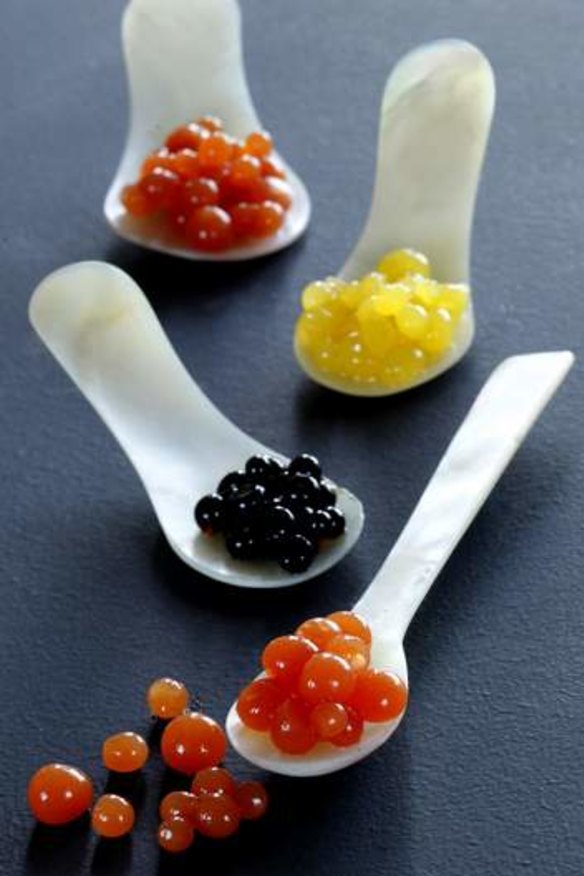Hot food: Faux roe
They might look like caviar, but there's nothing fishy about these balls that add zip to cocktails and coffee.

What are they?
Caviar pearls are small pearls of gel that add punchy pops of flavour to your food. Two very different techniques are popular. One, spherification, uses sodium alginate and calcium chloride to create a very thin outer membrane with a liquid centre. Created by Catalan chef Ferran Adria at elBulli in 2003, it has been used to great effect by chefs around the world, and now baristas and bartenders are using caviar pearls to add texture and theatre to coffee and cocktails. The second technique, gelification, creates caviar pearls of soft gel without the liquid centre, by combining liquid with agar-agar (a natural gelling agent derived from red algae seaweed), then dropping it into a cold liquid such as oil. Yes, kids, you can try this at home.
Where is it?
The team at Sydney's Rabbit Hole Bar & Dining play with hydrocolloids (any substance that forms a gel in water) to deliver some pretty out-there cocktails.
''We spherify tequila and sugar syrup in a bath of calcium chloride, and serve them with Cointreau pearls on top of a lime half, as a margarita,'' says co-owner Doug Laming. ''It's an added sensation that plays with your senses and gives people more than they were expecting.''
In Melbourne, spherification comes with extra caffeine at Industry Beans in Fitzroy, where you can order your coffee as espresso, Aeropress, cold-drip, siphon - or as single-origin coffee caviar. ''It's something that's a bit cool and a bit different,'' says co-owner Trevor Simmons. ''People put the caviar in their mouths, their eyes light up and they immediately start smiling.''
Why do I care?
It looks like magic, but acts like science.
Can I do it at home?
All you need is agar-agar powder, a clean eye-dropper, a tall vessel of well-chilled vegetable oil and a lab coat (optional). Start with orange juice (see recipe), as liquids with higher calcium content (for example, soy) require varying degrees of agar-agar.
Orange caviar pearls
These are delicious scattered over raw fish crudo with shaved fennel, or spooned over chocolate mousse, orange cake or ice-cream.
200ml clean, unused vegetable oil
150ml orange juice
1g (½ tsp) agar-agar powder
1 tbsp Cointreau (optional)
1. Place the vegetable oil in a tall glass jar and place upright in the freezer for 40 minutes to chill. When chilled, place the juice in a small pan and scatter the agar-agar powder over the top. Bring to the boil, whisking constantly, then remove and whisk in the Cointreau, if using. Allow to cool for about four minutes, until mixture reaches 50C.
2. Using a clean eye-dropper, drop the warm juice into the chilled oil, drop by drop. As the surface gels, the drops form a pearl shape and slowly sink to the bottom of the oil. (As you get good at it, you can make larger pearls by dropping a second and third drop immediately on top of the first.)
3. When you have enough, gently strain the pearls through a fine sieve, rinse, and drain on paper towel before serving.
Makes Hundreds
Sourcing
Agar-agar powder is available from health food shops and Asian food stores. For the curious, a range of molecular ingredients is available from chefspantry.com.au; essentialingredient.com.au; chefandthecook.com.au; and redspooncompany.com
NSW
Rabbit Hole Bar & Dining, 82 Elizabeth Street, Sydney 8084 2505, rabbitholebar.com.au
VIC
Industry Beans, Warehouse 3, corner Fitzroy and Rose streets, Fitzroy 03 9417 1034; Peninsula Larder, peninsulalarder.com.au
The best recipes from Australia's leading chefs straight to your inbox.
Sign up